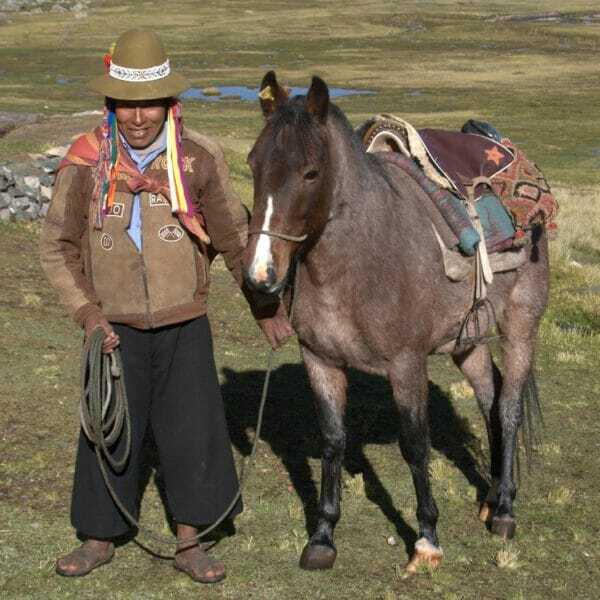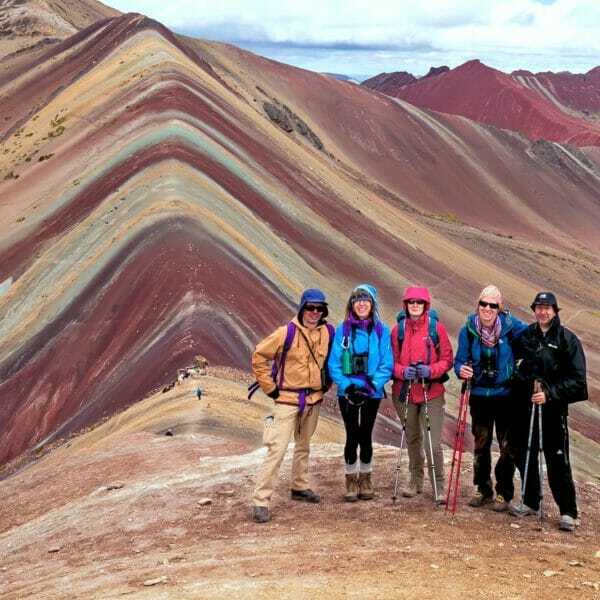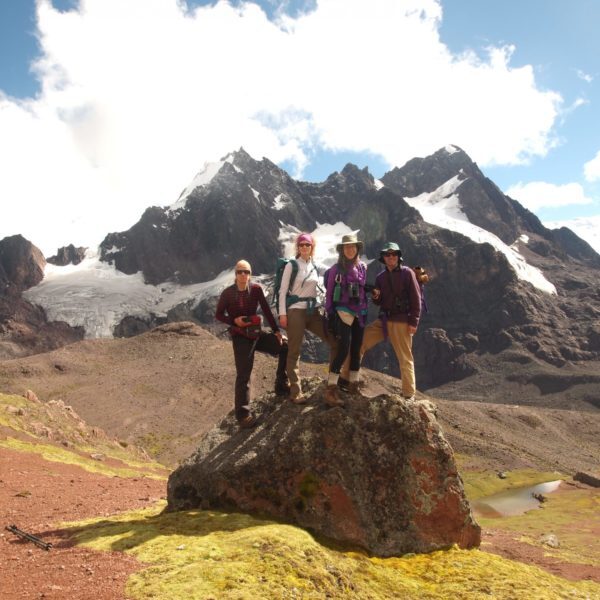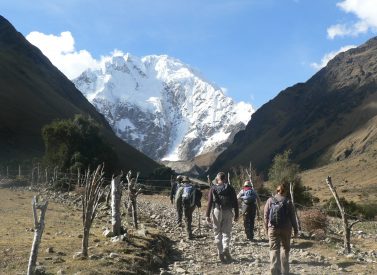
Ausangate Lodge and Rainbow Mountain trek
Trek the Rainbow Mountain in style on our Ausangate Lodge based trek through the breathtaking Cordillera Vilcanota in Peru.
After days spent walking through stunning high mountains you retire at night to comfortable eco-lodges, run by the local Chillca community.
The Ausangate lodge trek culminates with a trek to the famous Rainbow Mountain, arriving before the crowds.
The lodges are warmed by log burning stoves and rooms have private bathrooms and hot showers.
The local highland people are keen to share their culture with you, from music to song to making offerings to mountains.
More on Ausangate Lodge trek.
This stunning Ausangate trek requires you to acclimatise in Cusco or a similar high altitude area for a good 4 to 5 days before starting off.
You hike close to the highest and one of the most sacred mountains in the Cusco region. The local name of trek is taken from this mountain – Camino del Apu Ausangate.
The Apu is the bearer of life and the guardian of one of the pristine mountain ecosystems you will visit.
We’ll walk around six hours every day, covering 10-15 km depending on the altitude.
This fully-supported hike uses llamas and horses that are owned by the shepherds of two local communities.
These Andean people accompany us throughout the route and are proud to share their land and traditions every step of the way.
Trip Highlights
Print Share Download as PDF-
Complete the stunning Ausangate trek and visit the Rainbow Mountain before the crowds arrive.
-
Hike among beautiful mountains by day, sleep in cosy lodges at night.
-
Contribute to the Chillca way of life on this community-run tour.
-
Learn about Andean ways of life, listen to traditional songs and see dances.
-
Hot showers, private bathrooms and comfy beds to relax in.
-
Carry a day pack only as llamas and mules take your kit.
Speaking for myself, the Ausangate trip, end to end, was superb and was easily my high point.
The uniqueness of the trip, the quality of the walk, the height of the lodges, the warmth of the fellow guests, the genuine helpfulness and friendliness of the staff and guides all combined to make something extremely special and that I don't think could be repeated.
I believe the money paid to the local communities allow them to continue a number of things. It provides wages for guides, cleaners, housekeepers, chefs etc and allows them to stay in the mountains rather than having to move to townships but also through tourists buying direct from source the locals can carry on traditional customs like weaving/knitting/fishing etc thus prolonging their heritage.
A. McClure, Ausangate & Rainbow Mountain Trek
Full Itinerary
Day 1: Transfer Cusco-Checapue. Short hike to Chillca (L,D)
Early morning departure from Cusco (08.30 approx.) along the fertile Vilcanota Valley to the town of Checacupe (1.5 hours, 100km).
After a visit to the colonial temple of the Immaculate, we jump back into the van and start ascending the Pitumarca valley, along the spectacular Japura gorge that leads to Chillca. When we arrive we will be greeted by the community before setting off on a short and easy walk to the first “Tambo”(45 minutes).
Once at the lodge there is plenty of time to relax and enjoy the surroundings to the backdrop of music provided by the local musicians of Chillca.
Distance walked: 3.3km/2miles
Max height: 4,368m/14,331ft
Sleep at: 4,368m/14,331ft
Day 2: Chillca - Machuracay (B,L,D)
We wake early for breakfast as our hike begins at 08.30 in the wide valley of Upis. Here impressive glaciated mountains loom above the valley, offering majestic views.
The trail narrows as we make our way towards the waterfalls that tumble from from the Santa Catalina mountain. This path is mostly used by the wandering llamas of the area. When we reach the small Paloma lagoon, the countryside is dotted with these animals, along with a large number of alpacas.
After hiking past a second lagoon and crossing a series of moraines, we reach the Machuracay Tambo, located right at the bottom of the Apu Ausangate, where we spend the night.
Distance walked: 15km/9.1miles
Max height: 4,849mts/15,909ft
Sleep at: 4,815m/15,797ft
Day 3: Machurcay - Anantapata (B,L,D)
After breakfast is our first big challenge – a demanding crossing of the Palomani pass which sits at an elevation of 5,200m/17,060ft.
From the top, there are great views, and then we head down to Ausangatecocha. From here, there are tremendous views of the glaciated south face of Ausangate.
It doesn’t end there as we continue towards the striking red sandstone formations of the Nevado del Inca. Our Tambo for the night is Anantapata Tambo, where we enjoy a hearty meal. Batteries can be charged here as we have a solar panel for that purpose.
Distance walked: 11.6km/7.2miles
Max height: 5,150m/16,896ft
Sleep at: 4,750m/15,584ft
Day 4: Anantapata - Huampococha (B,L,D)
This day is a spectacular part of the trail. We hike between mountains of a myriad of colours, with red, ochre, and blue strata all shining forth. These mountains have become well known as the rainbow mountains of Ausangate and are one of the highlights of the trek.
It is an area of geological wonder and outstanding natural beauty. The fauna doesn’t disappoint either, so be on the lookout for groups of gracious vicuñas as they are frequently spotted in this remote and isolated area.
We sleep this night in the Huampococha Tambo, in the heart of large rock formations near a lagoon where huallatas (Andean geese) make their nests.
Distance walked: 12km/7.2miles
Max height: 4,954m/16,253ft
Sleep at: 4,800m/15,748ft
Day 5: Huampococha - Cusco (B)
Our last day sees us climb over our final pass, the Anta pass, and gradually make our descent from the mountains.
The landscape changes quickly as the red sandstone formations of the rainbow mountains are followed by limestone, forming a unique stone forest, and a perfect habitat for vizcacha, members of the chinchilla family.
We walk through small farming communities, past large herds of llamas and alpacas, and small plantations of potatoes, beans and quinoa. The women from the communities lay out some of their weavings to sell.
By the time we get down to the valley, our bus will be waiting for our return trip to Cusco.
Distance walked: 10km/6.5miles
Max height: 4,908m/16,102ft
Prices From $1,850 / £1,504 per person
What's Included?
Bilingual guide, private transport Cusco-Chillca-Cusco, lodging in twin/double rooms with private bathroom, duffle bag (for luggage carried by horse), all meals on the trek (B = breakfast, L = lunch, D = dinner).
What's Not Included?
International flights, insurance, tips, personal items, laundry, alcoholic drinks.
Accommodation
You stay at four different eco-lodges, called Tambos, as you walk the trail.
The tambos are eco-friendly, solid stone-constructions with local materials; fully integrated into the breathtaking landscapes of the towering Andes.
Each lodge houses 10 cozy double occupancy bedrooms, tastefully decorated with native textiles and local mahogany furniture. All rooms are equipped with thermal duvets and a private bathroom with running cold and hot water, tapped from nearby springs.
There is no electricity in the lodges (propane gas is used for cooking and firewood for heating) natural light sources such as candles and lanterns contribute to the ambience. There is nothing more invigorating than the magic of the Andean sky and the myriad of stars and constellations visible on a clear night.
After a long day’s journey, hikers will be warmed with a delicious local meal in the inviting restaurant while enjoying spectacular views of the Apu Ausangate and other peaks in the Cordillera Vilcanota.
Chillca Tambo: The first Lodge is located in the Uyuni Pampa, at an altitude of 4,368m/14,331ft.
It is a valley with meadows, furrowed by the ice-cold waters of the Quencomayo River, and a grazing place for a great number of alpacas from the community of Chillca. From the lodge, there is a privileged view of the snow-capped Mount Jatun Jampa; an Apu (Sacred Mountain) visible at the end of the valley.
Machuraccay Tambo: The second Lodge is the highest in the world, with 4,814m/15,797ft, and the closest to the Apu Ausangate, on one side of the moraine and climbing route. This is why this lodge is used as the base, to climb up Ausangate.
Not only does the lodge offer a spectacular view towards the snow-capped mountain, but, it also is surrounded by rocks among which lives a great quantity of wild viscachas, accustomed to human presence.
Anantapata Tambo: Anantapata is situated at an altitude of 4,750m/15,584 ft, at the top of the Alcatauri Gorge; a bofedal (Marshland) area, where the alpacas graze.
The gorge is embraced by the snow-capped Mount Tacusiri, to the North, and the Ausangate, to the East.
This comfortable lodge is different from the other three, as it was built with the Chillca community’s own funds. So, to the community, it is the most important one, since it is a testimony of the communities’ effort, to share their culture and landscapes, as well as proof of sustainable tourist development in the High Andean area.
Huampococho Tambo: The Huampococha Lodge occupies a magical location, at an altitude of 4,800m/15,748ft.
This lodge offers a panoramic view towards one of the most beautiful landscapes, encompassing the lagoon that bears the same name, and the snow-capped Mount of the Inca.
It rests at the foot of the Apu Callecalle, the summit of which is a set of intrusive rocky and jagged blades that point up to the sky – a beautiful and rough profile.
Huampococha is the ideal place for the observation of constellations and to listen to the Apus’ myths, and those of the alpaca shepherds’ gods.
Tour Staff
Your guide will meet you at your Cusco hotel, and will stay with you throughout the trip, advising you of any changes in plan etc. They will drop you off at the Cusco at the end of the trip.
Staff in the lodges, from cleaners to cooks to mule/llama herders, are all from the Chillca community. Your stay means that locals gain employment and help to preserve their way of life in the mountains.
Meals
Almost all dietary requirements can be catered for – contact us more more information.
Fully-trained staff at the lodges take care of all your meals, using a variety of local produce.
While trekking, you usually wake early. Your meals are prepared and served to you in the lodge and will be a mix of hot drinks, cereals, fruits and toast with jams.
After breakfast, packs are prepared and your guide will explain the day’s walk, and you typically walk 3-4 hours in the morning before lunch, with a short or break or two en route.
Lunch, while out walking, will be either sandwiches or meat and cheese, with fruits etc available on trips from the lodges, the food is great and varied.
After an hour or so for lunch – depending on weather conditions – you will continue your walk, usually 3-4 hours more, although some days are shorter or longer than others, and then relax before dinner at the lodge, where can really unwind in comfort.
Evening meals will feature soups, large main meals with potatoes/rice etc and puddings.
After eating, you can choose to socialise with team members, relax in your room or lodge or take in the views.
It gets cold very soon after sunset, so most people will fall asleep early and then rise early the next day, helping to conserve energy.
Activity Level
We classified this as a moderate trek, but we must stress that you need to be very well acclimatised before setting off on this trek. Allow 3-4 nights in Cusco before attempting this hike.
During the trek, we will go over a mountain pass at 5,150m/16,896ft above sea level, and hike for 5-6 hours every day for five days.
Pre-trip preparation should include challenging cardiovascular exercise (including regular hikes on varied terrain) and a healthy, balanced diet.
Well-worn hiking boots are highly recommended.
All guests are encouraged to hike at their own pace, taking breaks whenever needed, to ensure a successful and enjoyable trek for all.
Most people go to bed fairly early after a long day trekking, to recover energy for the morning.
Those with no previous trekking experience can trek Ausangate, although experience of hiking is beneficial.
The trip is open to anyone with a positive attitude who wants to walk in a stunning and remote part of Peru’s Andes.
Practical Information
Introduction to Peru
Peru is the perfect holiday destination for adventure travellers that want an amazing variety of activity, geography and cultural travel experiences.
The breadth of travel experiences in Peru is breathtaking – from trekking in the Andes to Machu Picchu to the tropical jungle of the Amazon, and plenty in between.
The people of Peru make it a special destination too, with its colourful and traditional street life and friendly locals.
Kit list
Good kit is vital for every trip.
Book with Andean Trails and get 15% off Páramo’s fantastic ethical and high performance outdoor gear.
Overview
When planning for the climatic conditions encountered in the High Andes, layering is the most practical and versatile clothing system. It’s worth remembering that our clothing keeps us warm by retaining and isolating the heat we ourselves create.
To best maintain body heat, several layers of lightweight, warm and quick-drying clothing are far more efficient than one or two thick layers. Layers should have the following qualities:
- Breathability (able to wick away the humidity produced by sweat):
- Isolation (able to keep in the warm air our body produces); and
- Impermeability (able to impede the passing of wind and water).
First (base) layer: This layer wicks the sweat away from our skin, thus helping keep the body dry and warm. To this end, synthetic fabrics such as polypropylene should be used.
Mid layers: These isloating layers should also be synthetic (e.g. the known polar linings such as polartec or windblock, which are light and insulate twice as well as wool). Very important layers for retaining body heat.
Outer layer / shell: Finally, the vital layer which protects us from climatic adversities. A breathable, wind-proof and waterproof anorak, such as Goretex.
Give plenty of thought to kit selection, and try to keep weight down. Below is a more detailed guide.
Detailed kit list
- 2 pairs synthetic inner socks (e.g. polypropylene, thermastat, coolmax) and 2 pairs thick loop-stitch/wool socks for cold.
- Trekking boots – should be well broken-in, waterproof and provide good ankle support.
- Trainers/sandals for city-wear, evenings at lower camps & river crossings.
- Base layer leggings (1 pair).
- Thick fleece leggings (or salopettes) (1 pair).
- Goretex-type over-trousers (or salopettes) (1 pair).
- Trekking trousers (2 pairs).
- Shorts – wear sparingly in early stages at altitude, as sun burns.
- Thermal base layer shirts (2).
- Microfleece mid-layer shirt (1).
- Shirt/t-shirt 1 or 2 for lower altitudes. Long-sleeved, collared shirt protects against sun
- Fleece jacket or similar (1).
- Warm jacket (down or synthetic). For camp and upper slopes.
- Waterproof Goretex-type jacket.
- Broad-brimmed sunhat, essential.
- Warm hat, fleece or wool. (N.B. Up to 30% of body heat can be lost through the head).
- Sunglasses with UV filter.
- Scarf for cold.
- Bandanna – to protect neck from strong sun.
- Light inner gloves
- Warm gloves, e.g. fleece, and outer waterproof gloves or mittens (1 pair)
- Mittens allow you to keep the fingers together, and better conserve heat (though they also make it difficult to perform certain tasks).
- Daypack (at least 30 litres). Comfortable and with waterproof lining or cover.
- Pair of telescopic trekking poles (optional). Note: You must have rubber tips on your poles if you tour visits Machu Picchu.
- Duffel bag or large rucksack for extra clothing, carried by horse/mule/porter while you are trekking.
- Water bottle (2 litres approx.).
- First-aid kit.
- Towel & wash-kit.
- Wet Wipes/antiseptic hand-wash cream.
- Sunscreen (factor 40+) and lip salve.
- Head-lamp (plus spare bulb and batteries).
- Penknife.
- Travel alarm clock.
- Plastic bags – ‘Zip-loc’ & tough bin liners.
- Camera and film / memory cards (take at least twice the amount you think you will need!).
- Book, e-book, mp3 player/ipod or other for free time.
- Binoculars.
- Spanish/English phrasebook.
All other non-personal trekking gear is provided at the lodges e.g. bedding, cutlery etc,
Miscellaneous others
- Money belt.
- Passport.
- U.S. dollars cash, mixed-denomination notes, undamaged and unmarked.
- ATM cash/credit card.
- Any inoculation certificates.
- Personal & medical insurance certificates.
- Presents e.g. Postcards from home.
Fitness
In order to get the most out of a trek we classify as ‘moderate‘, you should be in good physical condition.
It is not easy to grade the fitness level required for any trek, since it is a subjective matter.
However, for treks classified as moderate, expect to trek 5-7 hours per day carrying only your day-pack, with several long ascents and descents.
Altitude
Being at altitude, especially in the tropics, is usually a pleasure as it isn’t so hot, there are few insects and the air is clear.
However, when gaining altitude, air pressure drops and the amount of oxygen reaching the lungs is reduced. Although we build plenty of acclimatisation time into our itineraries, certain ill-effects are possible. Nevertheless, all of these can be minimised or prevented if care is taken.
On reaching heights above 2,500m (approx. 8,200 ft), especially when ascent has been straight from sea level, heart pounding, mild headache and shortness of breath are normal, especially on exertion.
Acute mountain sickness (AMS) is a syndrome known locally as soroche, whose symptoms can include of bad headache, dizziness and nausea).
To avoid AMS, you should:
- Rest for a few hours on arrival at altitude and take it easy for the first couple of days. Note: you may feel fine on arrival and tempted to exert yourself as normal. Don’t be fooled: you might be benefiting from oxygen brought in your blood from sea level.
- Drink plenty of water to avoid dehydration (altitude is a diuretic). Coca tea (mate de coca) helps alleviate symptoms.
- Eat light meals, with high carbohydrate and low fat and protein content. Dine early, allowing digestion time pre-sleep.
- Avoid over-exposure to the strong highland sun (UV rays are very powerful) – especially in the early stages – making sure you wear a broad brimmed sunhat. Apply lip-salve to prevent chapped lips.
- Avoid or minimise consumption of cigarettes and alcohol. Avoid sleeping pills.
- If you do get AMS: Rest, take non-aspirin painkillers (for headache) and coca tea. Symptoms should subside after a day or two.
- Pregnant women, people with a history of heart, lung, kidney or blood disease or blood pressure problems, should consult their doctor before traveling to high altitude.
ATOL holiday protection
Andean Trails has 25 years of experience of putting together the best South America holidays.
We pay a fee to the CAA for every licensable passenger we book since we hold an Air Travel Organiser’s Licence granted by the Civil Aviation Authority. In the unlikely event of our insolvency, the CAA will ensure that you are not stranded abroad and will arrange to refund any money you have paid to us for an advance booking.
We also offer ATOL (Civil Aviation Authority) protected holidays to give our customers peace of mind when booking and travelling.
When you buy an ATOL protected air holiday package from Andean Trails Ltd you will receive a Confirmation Invoice from us confirming your arrangements and your protection under our Air Travel Organiser’s Licence number 6275.
You can read more about ATOL, who is covered and what protections you have if not ATOL-covered, on our ATOL page.
What is ATOL?
The CAA’s ATOL scheme offers protection to your money and your holiday if you book with us. Not everybody is covered (see ‘Who is covered?’ for more), as you must purchase an ‘air package holiday’ with Andean Trails to be protected.
And ‘air package holiday’ is defined as including a flight and some ground services (hotel, transfer, trek etc). This is also known as an ‘ATOL-protected holiday’.
Who is covered?
To be covered by ATOL, you must book a flight and some ground services with us and be from the UK. If you are from the UK and only book ground services and no flights, you are not covered by ATOL (see below for more on how non-ATOL clients are covered).
If you are outside the UK and buy flights with us, you will be ATOL protected IF any of the flights booked with Andean Trails touches/stops in the UK at any point during your holiday package booked with us.
If you buy your flights elsewhere, please check with that agent if you are ATOL protected. Be careful with online flight purchases and make sure you know what protection you have, if any, before paying for flights.
Not all holiday or travel services offered and sold by us will be protected by the ATOL scheme. Please ask us to confirm what protection may apply to your booking.
For land only holidays not involving any air travel, in accordance with “The Package Travel, Package Holidays and Package Tours Regulations 1992”, all UK passengers booking with Andean Trails Ltd. are fully protected for the initial deposit and subsequently the balance of all money paid to us, arising from cancellation or curtailment of travel arrangements due to the insolvency of Andean Trails.
I’m not ATOL covered, what protection do I have?
If you are not ATOL covered, any payments you make to us go to a Trust account.
We can only access this money once your tour has been completed, meaning that if anything happens to Andean Trails Limited while you are on holiday, then your money is secure and you can either complete the trip or be able to make it home.
If you pay for your holiday with a credit card, some offer payment protection – please check with your cardholder.
You also should have cancellation protection written into your insurance (which we recommend you have at the time of booking) in case you need to cancel.
Available Dates


Dates & Prices
Select an available date to view pricing and information for that particular trip.
5-day trek, per person price, based on four people
Two people travelling together from USD2,790
Single room supplement applies
Daily private departures available. Mar-Nov
Can’t find what you’re looking for? Get in Touch
+44 (0)131 378 5593
+44 (0)131 554 6025























 a Group Tour
a Group Tour  a Tailor Made Tour
a Tailor Made Tour 









